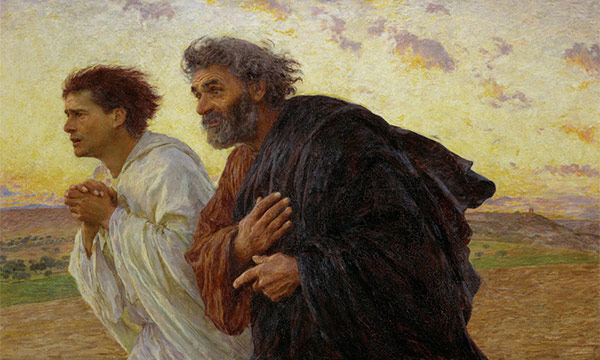Subtotal: $
Checkout
Bearers of a Divine Light
Illuminated images, made to reflect the love of Jesus to a world in need.
By Joel Clarkson
April 8, 2021
Color relies on its relationship with light to guide our focus toward a given point. Like the sun above us on a clear day, everything we see reflects the focal point of our own bright star, and the vision of the world itself ever points in return to that source. All that we know of color in our visual intake of the world – or, for that matter, of depth, contrast, angle, proportion, or any other seen aspect of it – is dependent on this light.
The most famous painting by the late-nineteenth-century painter Eugène Burnand is The Disciples Peter and John Running to the Sepulchre on the Morning of the Resurrection. In it, the viewer is shown a vision of the two disciples – one young, beardless, and clothed in white, with a passionate longing in his features; and the other, old, gray, with haggard hair and beard, robed in dark colors, with a look of astonished hope written into the worried lines of his worn face. Their bodies are angled heavily toward the left side of the painting, as if in frantic motion. Behind them, an open landscape reveals a scene on the edges of dawn, with a scattering of purple clouds hovering behind. The color and proportion of the image is striking in itself, opening up a sense of urgency and expectation; and yet, there is an additional aspect, the source of which remains out-of-frame in the image, that provides the viewer with the understanding that this expectation will not be disappointed. For on the leading edge of the violet clouds behind, rich orange and gold burns out in the direction of the disciples’ sprint. And in their eyes, a warm, reflective glow of what remains just beyond the left edge of the frame catalyzes the anticipation which their bodies express in their movement. It is in the use of light, and particularly the placing of the source of that light out of the frame, that the narrative gives impetus to the painting, evoking both the literal and the metaphorical dawn which the disciples seek. For the hidden sunlight plays not only as answer to the promise written in the illuminated colors of the image, but as the heightening of the desire for what the disciples themselves seek and yet remains just out of frame, the risen Christ. The use of light in Burnand’s painting plays as the catalyst which invokes in our hearts the same hope implanted in the two disciples, the longing for the rising of Christ, the sun of righteousness, to burst bright and true over the shadowy landscapes of our lives.
This sense of the way light plays with color to heighten our spiritual awareness of that which we receive through our sight has a long and storied history, and one of the most potent expressions of it is in the medieval tradition of illuminating manuscripts.
Illuminated manuscripts are iterations of the words of Scripture brought into animated life by vibrant patterns, colors, textures, and depictions surrounding the words. The best way to imagine an illuminated manuscript if you have never seen one might be to think of it as stained glass on parchment; and like stained glass, it reveals the stories of the Bible in vivified visual expression. The artisan monks who brought this magnificent work to bear spared no expense in their craftsmanship: they used pigments and inks of the rarest materials, from blue Persian lapis lazuli to crimson-hued kermes from the Mediterranean Sea, from precious silver to exceedingly rare gold flake. The artisans of these illuminated manuscripts collected and expertly applied such extravagant elements toward a singular purpose: to beautify and sanctify the glorious words of sacred Scripture.
Just as the words of the Bible flow out into the drama of our lives, so, too, do we bear forth the spirit of emanating light expressed in illuminated manuscripts.
Many of the most captivating works of illumination were completed during times of great turmoil. The Book of Kells, perhaps the most known and most celebrated illuminated manuscript preserved up to our own time, was completed even in light of multiple Viking raids, and amid the death and destruction of the sacking of monasteries, with monks fleeing into the hills. The strange contrast between the industriousness of the exquisite craftsmanship that produced such brilliant and beautiful works and the impinging existential threat of war and violence which cast such communities into the dire circumstances of mere survival, is stark indeed. What could possibly cause these monks to persist in such a seemingly excessive pursuit during such pressing, challenging times?
For these monastic orders, to read the gospel was not merely to receive information but rather to engage with a living story. The text on the page was more than a mere collection of words; it was the light of God’s divine truth shining out into the lives of all who read it. In a time before mass printing, when every text had to be produced by hand, the value of a single manuscript was far beyond what we could understand in our own time of literary proliferation. And these monks knew that unlike any other book in the world, the bracing words of the prophets and apostles, the enlivening poetry of the Psalms and the prose of the Gospels, each verse of Scripture was the inspired word of God, and thus was a witness to the true word, the living Logos, Christ, whose presence shone through it. Any book was rare in that time; but the words of Scripture were beyond price itself. To bring anything less than the most expressive and glorious of casts and hues to bear would be to dim the inner light imbued in the words themselves.
And just as the words of the Bible flow out into the drama of our lives, so, too, do we bear forth the spirit of emanating light expressed in illuminated manuscripts. For we are also made for illumination. Like images which reveal the goodness of their color, texture, and movement through the in-breaking of light, we were made to be bearers of a divine light, which similarly animates us.

Eugène Burnand, Peter and John Running to the Tomb on the Morning of the Resurrection
In a part of the sanctuary in my church in St. Andrews, tucked away in the corner of a high ceiling, a window provides an unexpected (and perhaps unintended) engagement with light that interacts with those who gather for worship below. Because of its placement, and because it is made up of regular clear glass rather than the stained glass of the rest of the interior, during morning services on a clear day, sunlight pours through and down into the apse below, where the congregants sit in their pews. Often, during a homily or while kneeling during the prayers of the people, I’ll glance over toward the gathered congregation and see a strange, otherworldly sight: a single beam of light, pouring down into the congregation, its path articulated by the swirling mist of incense, falling on a favored individual. Often, these people will have their eyes closed against the blinding brightness, which only serves to heighten the sense of the strange, heavenly calm, the sudden instance of an eternal brightness pressing out at the seams of the world in our moment of worship. A few moments later, the beam will have selected another person, and then another, moving with graceful elegance along rows of the gathered faithful, as if to reveal their inner selves, the true glory present in them, so often obscured behind the preoccupation of everyday life, but now brought to the fore in worship. As if momentarily transported to the mount of transfiguration, they burn bright with the Christ-light within them, and I find myself humbled and awed, transfixed in the gaze of a divine love. And I am reminded that even in my imperfection, even in my uncertainty and apprehension, I, too, bear that fire in me, and the loving gaze I perceive in the transfigured images of my fellow Christian brothers and sisters is on me as well, waiting to set my heart aglow.
To truly behold the sacredness imbued in image, to apprehend the divine light expressed within it, is not merely to see but to be seen.
Like stained glass which refracts sunlight into the inner world of a church sanctuary, or like sacred images which channel the eye of the beholder outward to the person who is the fullness of what the image contains, every human bears an imprint of an image, an image which, in Christ, might be set aflame with heavenly light. We who know and follow Jesus are illuminated images, made to reflect the divine light of Jesus to a world in need, acting as sacred depictions of God’s love which might redirect longing eyes toward the fulfillment of their desires in him.
And we are able to be such expressions of grace not only because of our witness to the light but because we are seen by the light. As Christ-bearing images, we receive the love of a Father who has adopted us as sons and daughters. The delight we behold in the aspect of his eyes is the love He has for us, and the joy he takes in bearing forth the life of his light through his Son in us.
To truly behold the sacredness imbued in image, to apprehend the divine light expressed within it, is not merely to see but to be seen. The transcendent joy of the visual world which we receive every day is not truly in what we do to behold but in what God does to make us light bearers. When, as Christians, we see, when we comprehend, we do it from the basis of the gift of God’s self to us in and through Christ. This gift is the image placed within our very selves from the beginning, and it is the restoration of the illumination of that image once more through God’s gift of himself that amid the many who wander in darkness, we might, in the words of Philippians 2:15-16 (NIV), “shine among them like stars in the sky as [we] hold firmly to the word of life.”
Taken from Sensing God by Joel Clarkson. Copyright © 2021. Used by permission of NavPress. All rights reserved. Represented by Tyndale House Publishers, a Division of Tyndale House Ministries.
Already a subscriber? Sign in
Try 3 months of unlimited access. Start your FREE TRIAL today. Cancel anytime.






